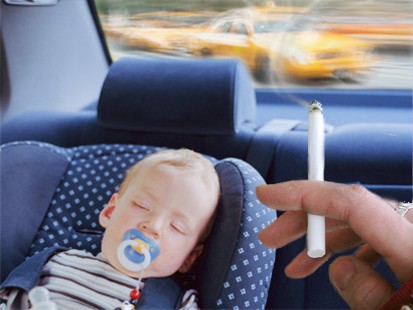Passive smoking is the inhalation of smoke, called secondhand smoke (SHS) or environmental tobacco smoke (ETS), from tobacco products used by others. It occurs when tobacco smoke permeates any environment, causing its inhalation by people within that environment.

Scientific evidence shows that exposure to secondhand tobacco smoke causes disease, disability, and death.
Bars, restaurants, sporting events, concerts, and social gatherings, public places where drinks and food are served is where passive smoking commonly occurs.
While laws are in place banning smoking in public and workplaces, many non-smokers are exposed to a large amount of passive smoke in their own homes, or in the homes of family and friends. Smoke tends to linger in the air for hours, especially in enclosed spaces.
Even when the smoker goes out, smoke residues stick to the clothes and skin of those who smoke exposing children, specifically infants and toddlers to them.

Most of the passive smoking risks are similar to those associated with actually smoking a cigarette, pipe or cigar. Inhaling secondhand smoke causes lung cancer in nonsmoking adults.
Secondhand smoke is associated with disease and premature death in nonsmoking adults and children. Exposure to secondhand smoke irritates the airways and has immediate harmful effects on a person’s heart and blood vessels. It may increase the risk of heart disease by an estimated 25 to 30 percent.
The victims of passive smoking pay the price for others’ harmful activities, sometimes the direct smokers being their own family members. 40 percent children, 35 percent women and 33 percent are exposed to second-hand tobacco smoke. Half the deaths caused by passive smoking are those of women, the other half include both children and men.

Passive smokers face an equal risk of the dangerous results of smoking which can also be fatal. Almost 35 percent of the passive smokers are children.
Infants born to mothers who have smoked during pregnancy are lighter and shorter compared to infants of non-smoking mothers.
Children exposed to secondhand smoke are at increased risk of Sudden Infant Death Syndrome (SIDS), ear infections, colds, pneumonia, bronchitis, and more severe asthma. Being exposed to secondhand smoke slows the growth of children’s lungs and can cause them to cough, wheeze, and feel breathless.

A new study, led by researchers at Nottingham University, has revealed that pregnant non-smokers who breathe in the second-hand smoke of other people are at an increased risk of delivering stillborn babies or babies with defects.
The study found passive smoking increased the risk of still birth by almost one-quarter (23 per cent) and was linked to a 13 per cent increased risk of congenital birth defects.
The findings underline the importance of discouraging expectant fathers from smoking around their pregnant partners and warning women of the potential dangers of second-hand smoke both pre-conception and during pregnancy.
Bars, restaurants, sporting events, concerts, and social gatherings, public places where drinks and food are served is where passive smoking commonly occurs.
While laws are in place banning smoking in public and workplaces, many non-smokers are exposed to a large amount of passive smoke in their own homes, or in the homes of family and friends. Smoke tends to linger in the air for hours, especially in enclosed spaces.
Even when the smoker goes out, smoke residues stick to the clothes and skin of those who smoke exposing children, specifically infants and toddlers to them.
Risks and Effects
Epidemiological studies have revealed that non-smokers exposed to secondhand smoke are at risk for many of the health problems associated with direct smoking.
Most of the passive smoking risks are similar to those associated with actually smoking a cigarette, pipe or cigar. Inhaling secondhand smoke causes lung cancer in nonsmoking adults.
Secondhand smoke is associated with disease and premature death in nonsmoking adults and children. Exposure to secondhand smoke irritates the airways and has immediate harmful effects on a person’s heart and blood vessels. It may increase the risk of heart disease by an estimated 25 to 30 percent.
The victims of passive smoking pay the price for others’ harmful activities, sometimes the direct smokers being their own family members. 40 percent children, 35 percent women and 33 percent are exposed to second-hand tobacco smoke. Half the deaths caused by passive smoking are those of women, the other half include both children and men.

Passive smokers face an equal risk of the dangerous results of smoking which can also be fatal. Almost 35 percent of the passive smokers are children.
Infants born to mothers who have smoked during pregnancy are lighter and shorter compared to infants of non-smoking mothers.
Children exposed to secondhand smoke are at increased risk of Sudden Infant Death Syndrome (SIDS), ear infections, colds, pneumonia, bronchitis, and more severe asthma. Being exposed to secondhand smoke slows the growth of children’s lungs and can cause them to cough, wheeze, and feel breathless.

A new study, led by researchers at Nottingham University, has revealed that pregnant non-smokers who breathe in the second-hand smoke of other people are at an increased risk of delivering stillborn babies or babies with defects.
The study found passive smoking increased the risk of still birth by almost one-quarter (23 per cent) and was linked to a 13 per cent increased risk of congenital birth defects.
The findings underline the importance of discouraging expectant fathers from smoking around their pregnant partners and warning women of the potential dangers of second-hand smoke both pre-conception and during pregnancy.






0 comments
Post a Comment